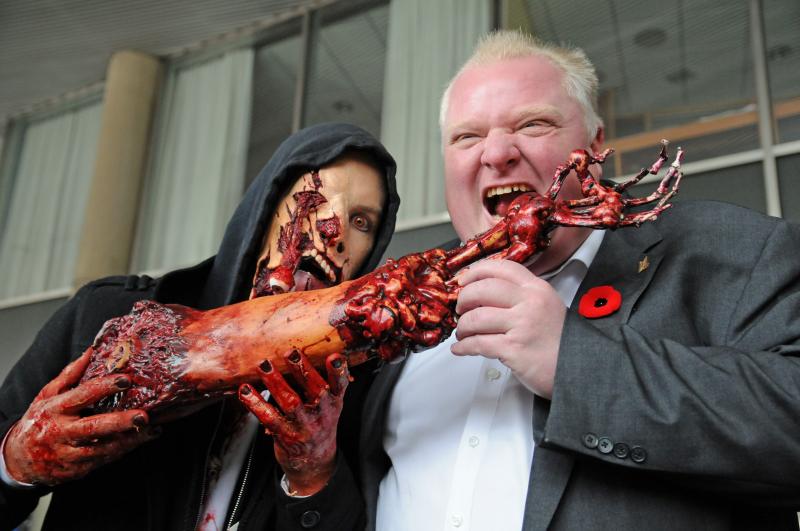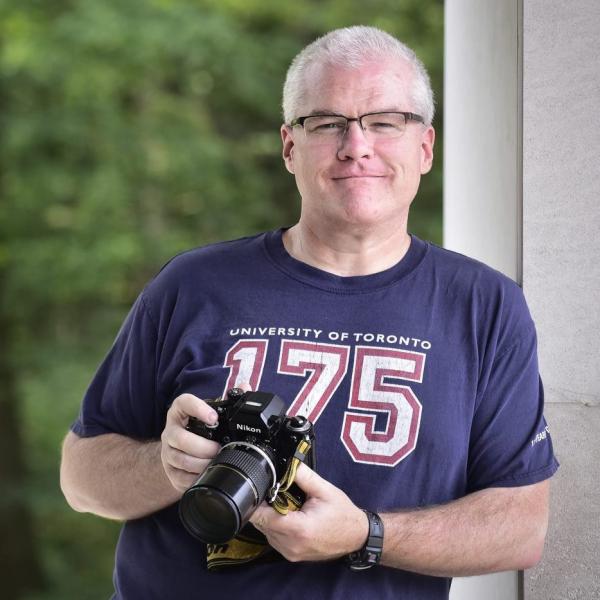Kevin Proulx (BA UTSC 1992) revealed an eye for the visionary at a young age. At 18, Proulx reached out to – and interviewed – some of the world’s most beloved science fiction and fantasy authors: Clive Barker and George R. R. Martin, Chelsea Quinn Yarbo and Joe R. Landsdale, to name a few. He collected the interviews into a book published by Starmont House publishing in 1991, while he was still an undergraduate English Literature major at UTSC. The press went under that year, but Proulx managed to revive his collection digitally.
The intrepid high schooler mailed questions on cassette tape to the authors, and received taped answers in return. “They never saw me,” which, Proulx reasons, may have been the secret to his success. The authors didn’t know the age of their interviewer. “I don’t think I appreciated what that [project] was at the time,” adds Proulx.
“People were making t-shirts. They made it into a meme."
And while ambitious in the realm of literature, it’s Proulx’s passion for photography that has allowed him to capture and reveal important stories – including his own.
Proulx began Third Eye Photographics in high school. (For his first job, he was paid $25 and a coupon for Mary Brown’s Chicken). He stuck with it throughout university, and after graduation, while he worked at publishing houses and other jobs, photography remained his side obsession.
“To make money as a photographer is difficult,” says Proulx, adding that, “With the advent of cell phones, everyone is a photographer.”
Sporting events, nature pics, street photography: Proulx dabbles in it all. His photos may have occupied a back seat to his day job, but Proulx has nonetheless snapped some iconic images over the years. He was the photographer behind the viral Rob Ford Zombie photo, for instance, taken as Proulx covered one of Toronto’s famous Zombie walks.
“People were making t-shirts. They made it into a meme,” says Proulx. The photo even circulated on a late-night talk show in the U.S., further cementing the image as a cultural flashpoint in Toronto’s rich cultural history.

For Proulx, that’s exactly what a good photograph should do. The camera lens is a means of preserving and fixing history. “Photography is about making things immortal. Sometimes it’s not capturing the truth, but it is time travel,” he says.
The remarkable transcendence of photography has allowed Proulx to tap into and explore his own history, too. Proulx’s father’s family hails from a small town north of Timmins. Although it was evident, his family’s Indigenous ancestry “wasn’t talked about.”
“Photography is about making things immortal. Sometimes it’s not capturing the truth, but it is time travel."
Proulx’s camera became the instrument that allowed him to get closer to those lost roots and learn about his ancestry in a tangible way. In 2017, Proulx volunteered to photograph the North American Indigenous Games. Proulx recalls the extraordinary atmosphere of the Games, held across the GTA at sites such as UTSC, and the remarkable spirit of the youth who competed. “I met a lot of kids who came from extremely isolated, rough rural communities,” says Proulx. “They were going back to no running water and no source of heat. But they were so upbeat, so happy to be there.”
Over the course of the two-week Games, Proulx covered those athletes competing in everything from basketball to swimming, as well as the opening ceremonies involving traditional dancing and drumming.
The photos Proulx took at the Games didn’t simplify his complex relationship to those roots, or his ability to celebrate them. Rather, Proulx explains that his camera was a “double-edged sword,” one that created a “bridge that allows you to connect” to that culture and ancestry, but one that ultimately relegated him to “the observer’s seat.” His distance is maintained as much by the camera as being “not from those communities.”
At the same time, Proulx maintains a deep ambivalence about shooting Indigenous events. He’s shot pow wows, for instance, but now feels that, even despite his ancestry, filming these powerful and moving events can be voyeuristic and exploitative.
And while the community he’s visited have been very welcoming, Proulx says that if he were to capture Indigenous events in future, he’d go about it differently. “I’d sit down with some elders and speak with them,” he says.

IMAGES: Top: Indigenous Dancer at Downsview cultural festival, 2016 (Kevin Proulx); Mid: Rob Ford and Zombie at Toronto Zombie Walk, 2013 (Kevin Proulx); Bottom: the photographer, Kevin Proulx (Ken Jones)
